Abstract
The vesicant agents of the unitary chemical munitions stockpile include various formulations of sulfur mustard [bis-(2-chloroethyl) sulfide; agents H, HD, and HT] and small quantities of the organic arsenical Lewisite [dichloro(2-chlorovinyl) arsine; agent L]. These agents can be dispersed in liquid, aerosol, or vapor form and are capable of producing severe chemical burns upon direct contact with tissue. Moist tissues such as the eyes, respiratory tract, and axillary areas are particularly affected. Available data summarizing acute dose response in humans and laboratory animals are summarized. Vesicant agents are also capable of generating delayed effects such as chronic bronchitis, carcinogenesis, or keratitis/keratopathy of the eye under appropriate conditions of exposure and dose. These effects may not become manifest until years following exposure. Risk analysis derived from carcinogenesis data indicates that sulfur mustard possesses a carcinogenic potency similar to that of benzo[a]pyrene. Because mustard agents are alkylating compounds, they destroy individual cells by reaction with cellular proteins, enzymes, RNA, and DNA. Once begun, tissue reaction is irreversible. Mustard agents are mutagenic; data for cellular and laboratory animal assays are presented. Reproductive effects have not been demonstrated in the offspring of laboratory rats. Acute Lewisite exposure has been implicated in cases of Bowen's disease, an intraepidermal squamous cell carcinoma. Lewisite is not known to generate reproductive or teratogenic effects.
Full text
PDF
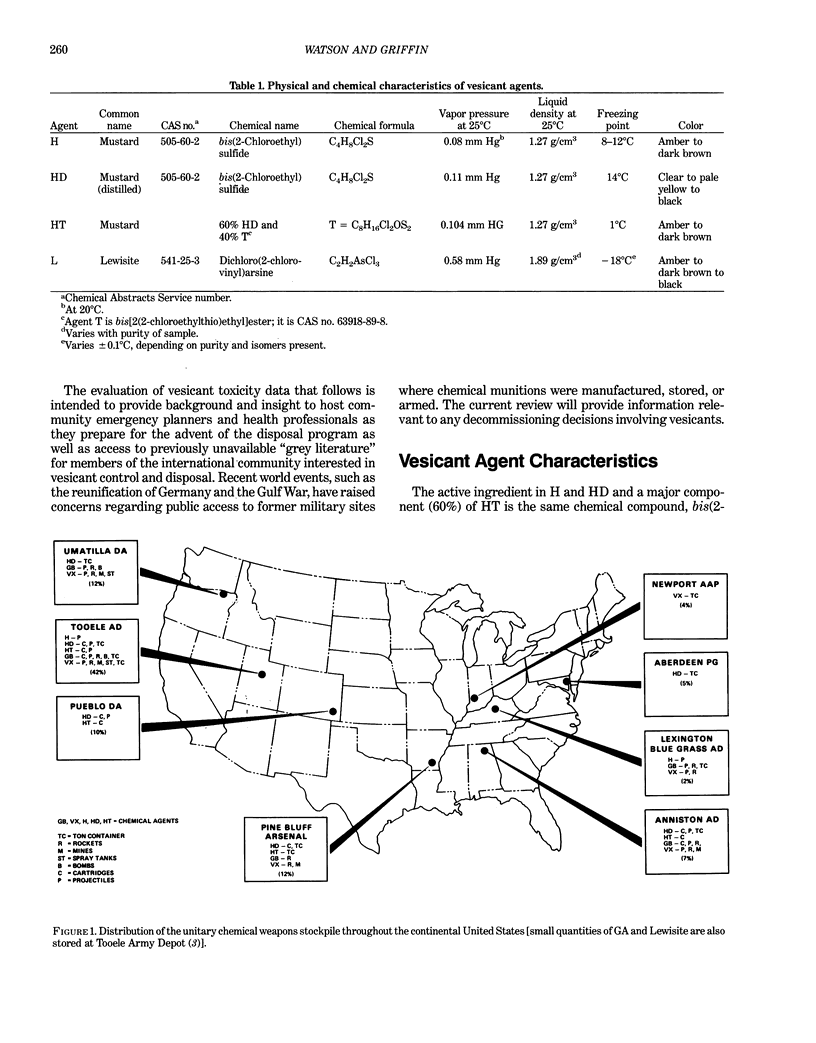

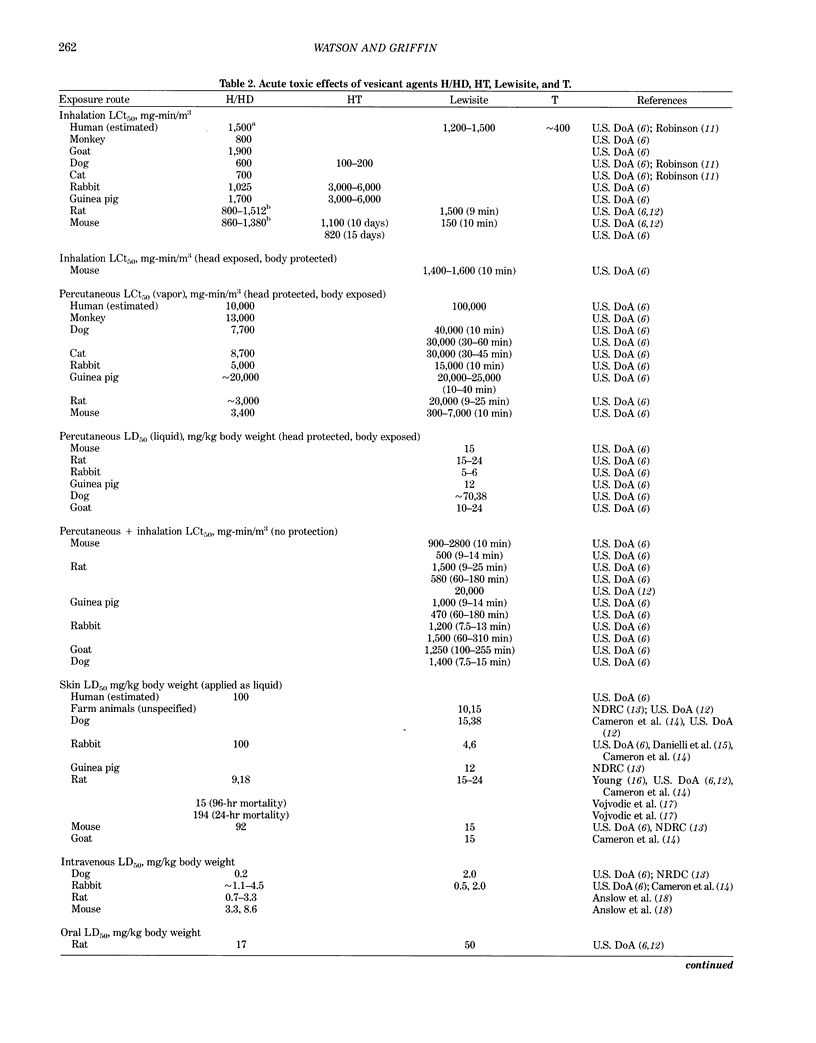
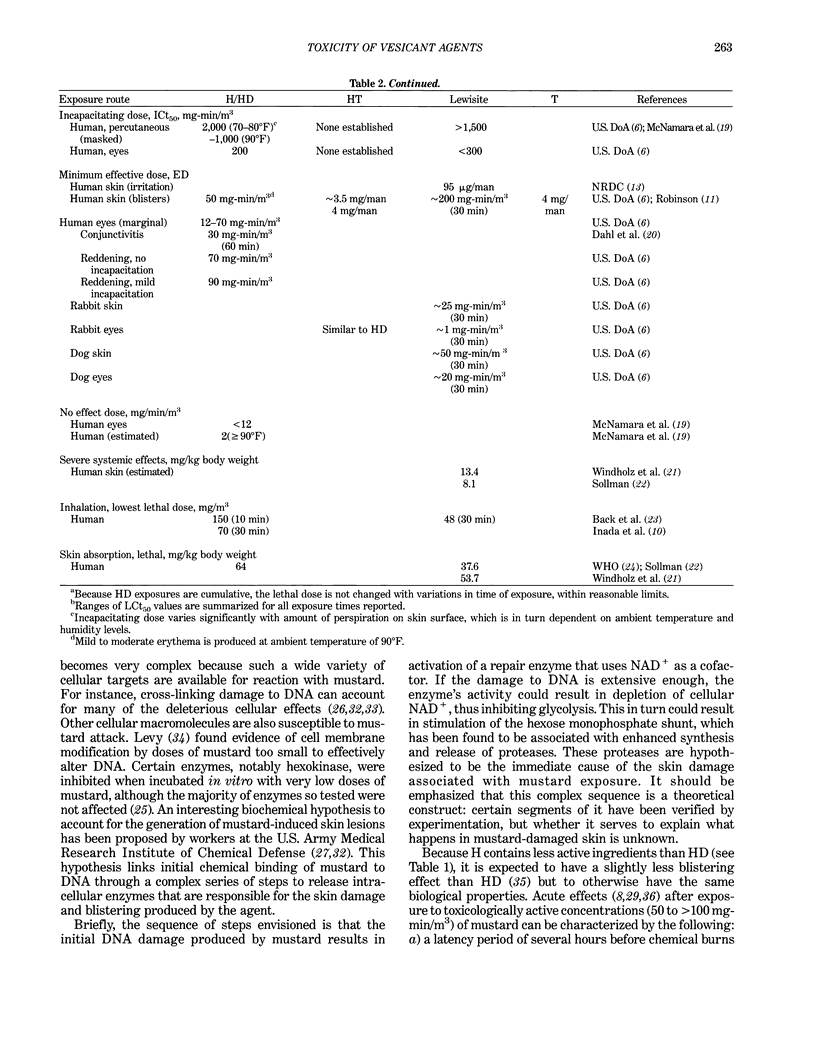


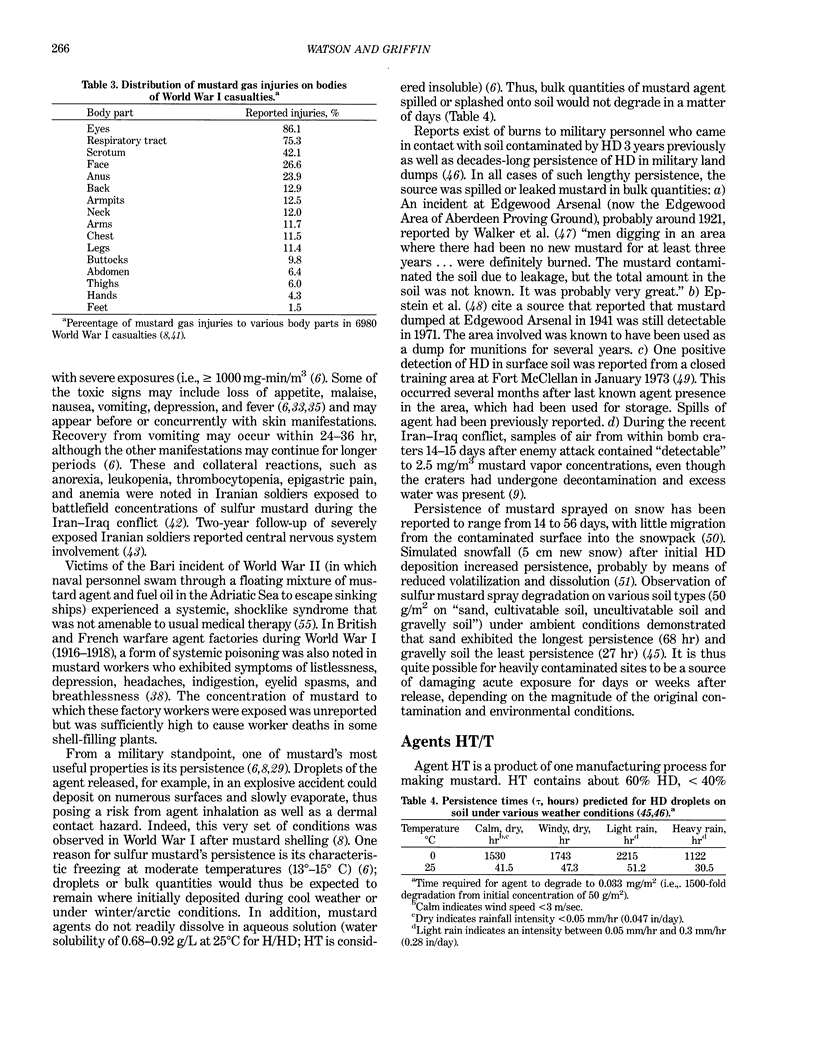


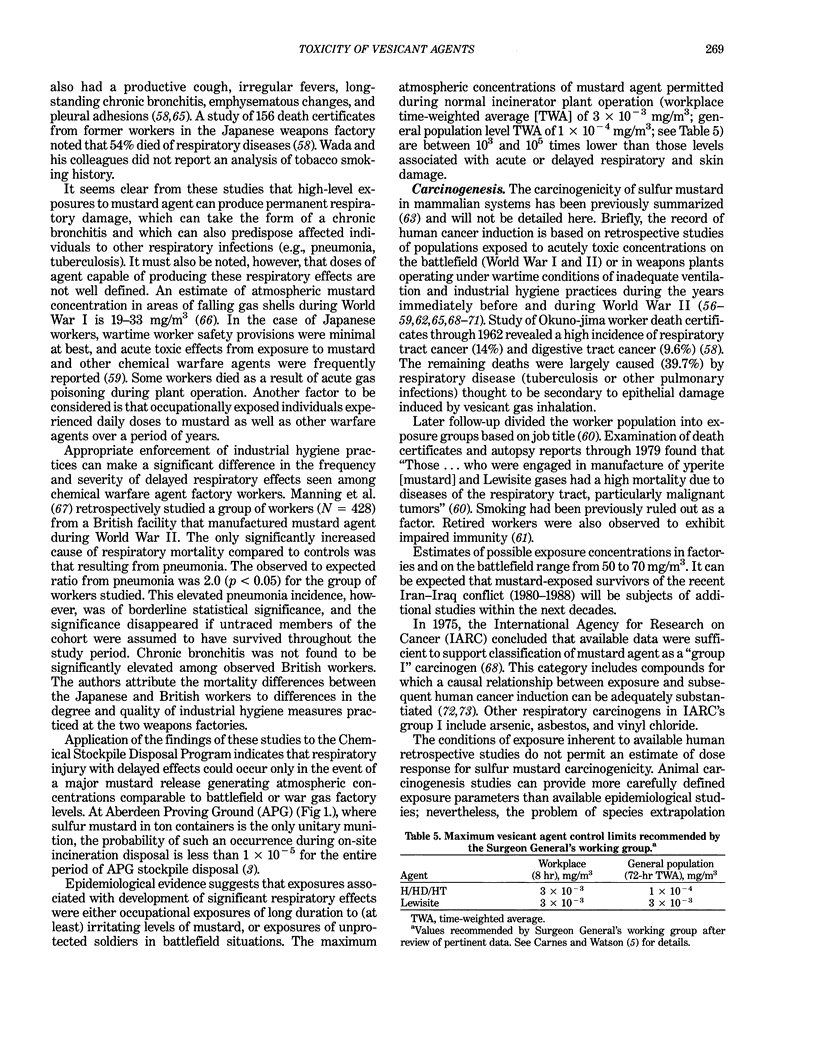

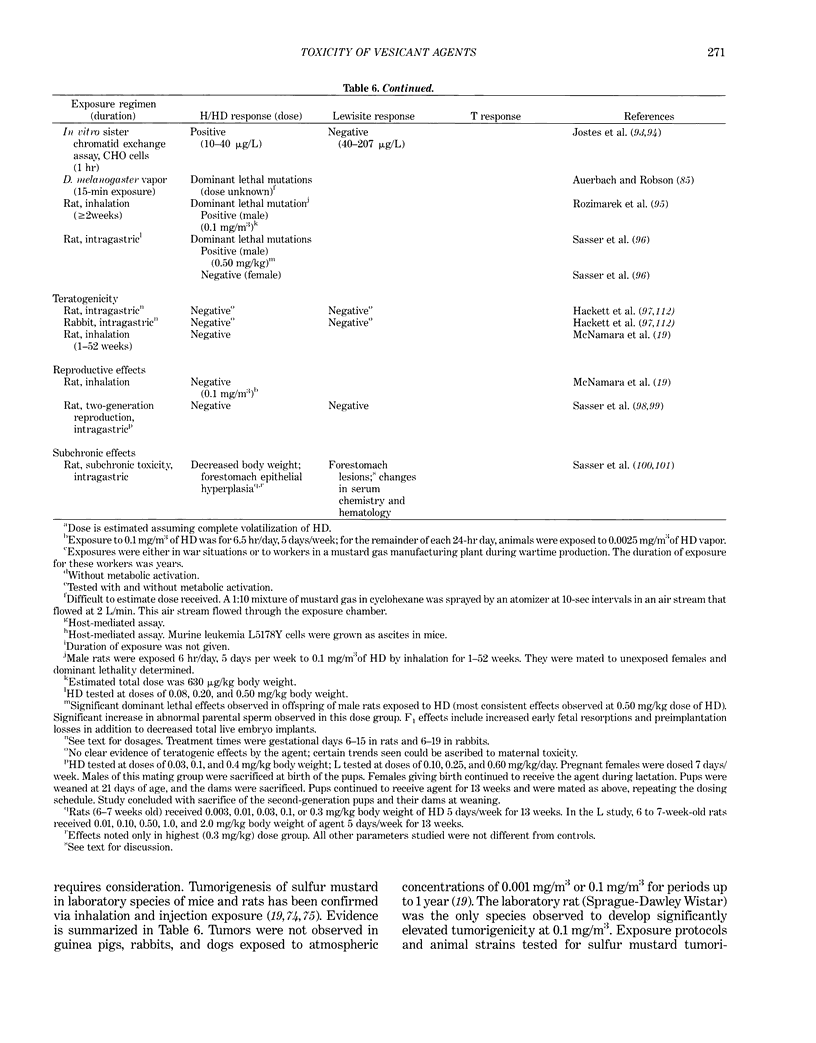


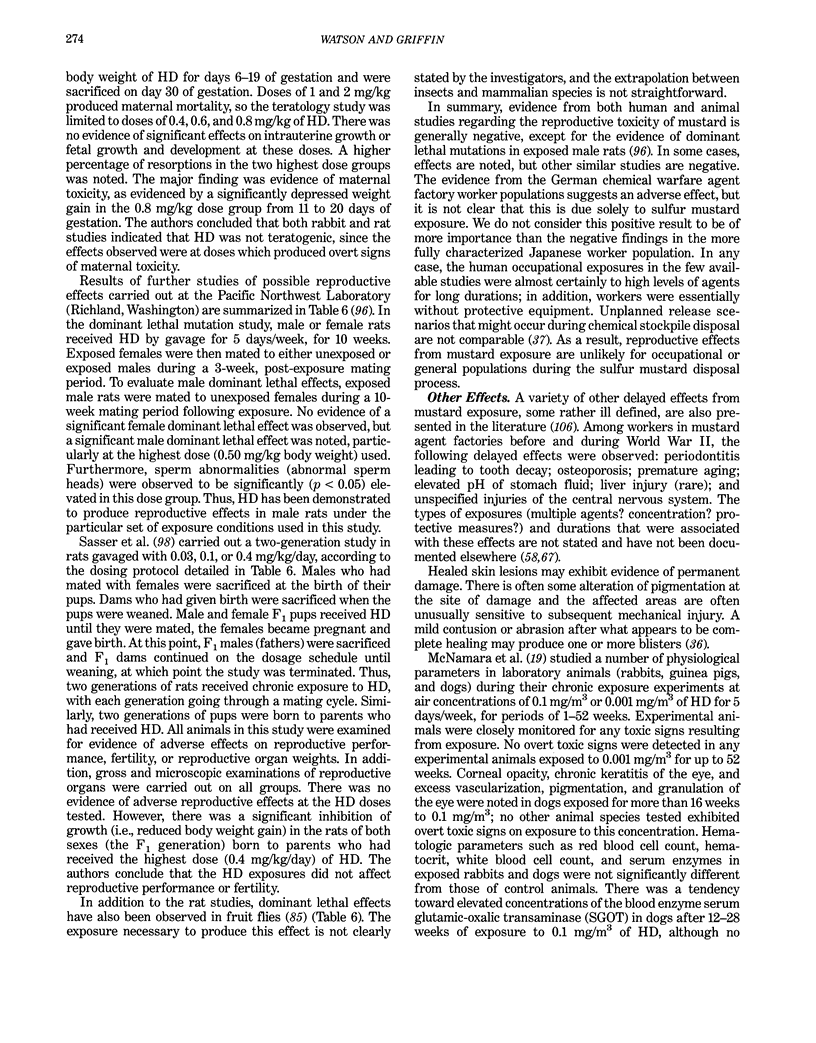
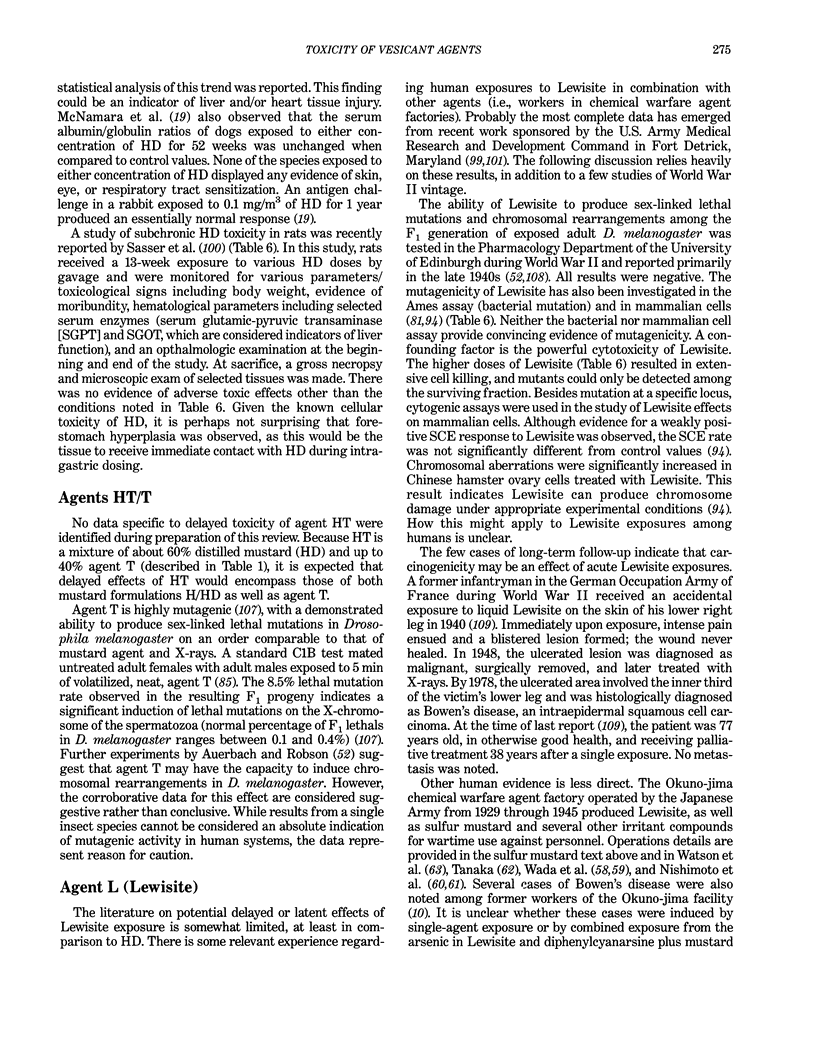

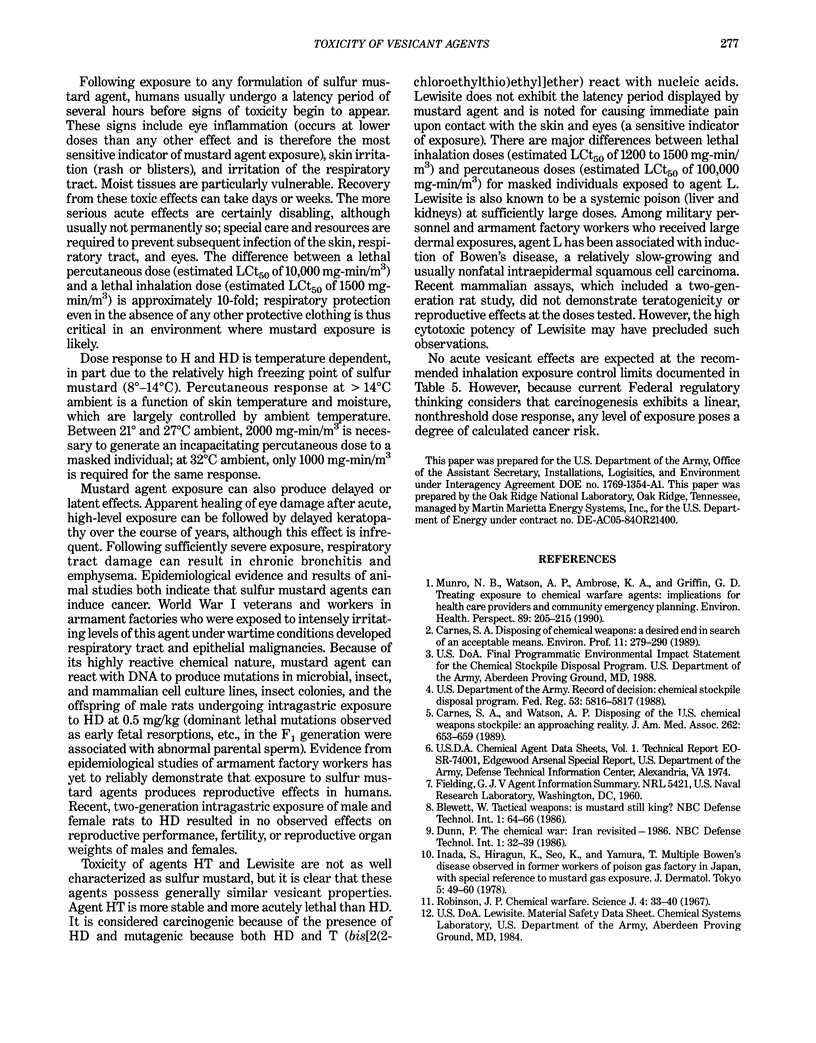
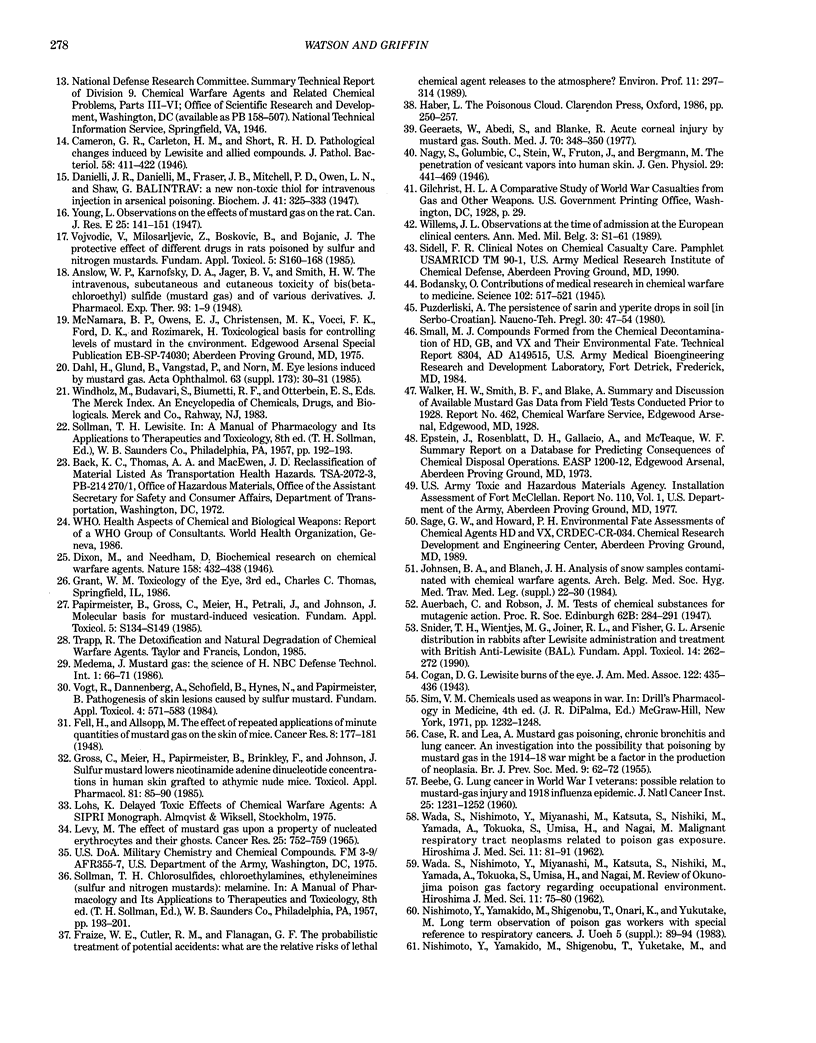


Selected References
These references are in PubMed. This may not be the complete list of references from this article.
- BEEBE G. W. Lung cancer in World War I veterans: possible relation to mustard-gas injury and 1918 influenza epidemic. J Natl Cancer Inst. 1960 Dec;25:1231–1252. [PubMed] [Google Scholar]
- Ball C. R., Roberts J. J. Estimation of interstrand DNA cross-linking resulting from mustard gas alkylation of HeLa cells. Chem Biol Interact. 1972 Mar;4(4):297–303. doi: 10.1016/0009-2797(72)90024-5. [DOI] [PubMed] [Google Scholar]
- Bodansky O. CONTRIBUTIONS OF MEDICAL RESEARCH IN CHEMICAL WARFARE TO MEDICINE. Science. 1945 Nov 23;102(2656):517–521. doi: 10.1126/science.102.2656.517. [DOI] [PubMed] [Google Scholar]
- Brookes P., Lawley P. D. The reaction of mono- and di-functional alkylating agents with nucleic acids. Biochem J. 1961 Sep;80(3):496–503. doi: 10.1042/bj0800496. [DOI] [PMC free article] [PubMed] [Google Scholar]
- CASE R. A., LEA A. J. Mustard gas poisoning, chronic bronchitis, and lung cancer; an investigation into the possibility that poisoning by mustard gas in the 1914-18 war might be a factor in the production of neoplasia. Br J Prev Soc Med. 1955 Apr;9(2):62–72. doi: 10.1136/jech.9.2.62. [DOI] [PMC free article] [PubMed] [Google Scholar]
- Carnes S. A., Watson A. P. Disposing of the US chemical weapons stockpile. An approaching reality. JAMA. 1989 Aug 4;262(5):653–659. [PubMed] [Google Scholar]
- DICKEY F. H., CLELAND G. H., LOTZ C. The role of organic peroxides in the induction of mutations. Proc Natl Acad Sci U S A. 1949 Oct;35(10):581–586. doi: 10.1073/pnas.35.10.581. [DOI] [PMC free article] [PubMed] [Google Scholar]
- Dahl H., Gluud B., Vangsted P., Norn M. Eye lesions induced by mustard gas. Acta Ophthalmol Suppl. 1985;173:30–31. doi: 10.1111/j.1755-3768.1985.tb06833.x. [DOI] [PubMed] [Google Scholar]
- Danielli J. F., Danielli M., Fraser J. B., Mitchell P. D., Owen L. N., Shaw G. BAL-INTRAV: a new non-toxic thiol for intravenous injection in arsenical poisoning: 1. Biological observations. 2. Chemical observations. Biochem J. 1947;41(3):325–333. [PMC free article] [PubMed] [Google Scholar]
- Fahmy O. G., Fahmy M. J. Mutability at specific euchromatic and heterochromatic loci with alkylating and nitroso compounds in Drosophila melanogaster. Mutat Res. 1971 Sep;13(1):19–34. doi: 10.1016/0027-5107(71)90122-9. [DOI] [PubMed] [Google Scholar]
- Fahmy O. G., Fahmy M. J. Mutagenic selectivity for the RNA-forming genes in relation to the carcinogenicity of alkylating agents and polycyclic aromatics. Cancer Res. 1972 Mar;32(3):550–557. [PubMed] [Google Scholar]
- Fox M., Scott D. The genetic toxicology of nitrogen and sulphur mustard. Mutat Res. 1980 Mar;75(2):131–168. doi: 10.1016/0165-1110(80)90012-3. [DOI] [PubMed] [Google Scholar]
- Garrett N. E., Stack H. F., Gross M. R., Waters M. D. An analysis of the spectra of genetic activity produced by known or suspected human carcinogens. Mutat Res. 1984 Sep-Nov;134(2-3):89–111. doi: 10.1016/0165-1110(84)90006-x. [DOI] [PubMed] [Google Scholar]
- Geeraets W. J., Abedi S., Blanke R. V. Acute corneal injury by mustard gas. South Med J. 1977 Mar;70(3):348–350. doi: 10.1097/00007611-197703000-00028. [DOI] [PubMed] [Google Scholar]
- Gross C. L., Meier H. L., Papirmeister B., Brinkley F. B., Johnson J. B. Sulfur mustard lowers nicotinamide adenine dinucleotide concentrations in human skin grafted to athymic nude mice. Toxicol Appl Pharmacol. 1985 Oct;81(1):85–90. doi: 10.1016/0041-008x(85)90123-1. [DOI] [PubMed] [Google Scholar]
- HESTON W. E. Carcinogenic action of the mustards. J Natl Cancer Inst. 1950 Oct;11(2):415–423. [PubMed] [Google Scholar]
- HESTON W. E. Occurrence of tumors in mice injected subcutaneously with sulfur mustard and nitrogen mustard. J Natl Cancer Inst. 1953 Aug;14(1):131–140. [PubMed] [Google Scholar]
- HESTON W. E. Pulmonary tumors in strain A mice exposed to mustard gas. Proc Soc Exp Biol Med. 1953 Mar;82(3):457–460. doi: 10.3181/00379727-82-20146. [DOI] [PubMed] [Google Scholar]
- Inada S., Hiragun K., Seo K., Yamura T. Multiple Bowen's disease observed in former workers of a poison gas factory in Japan, with special reference to mustard gas exposure. J Dermatol. 1978 Apr;5(2):49–60. doi: 10.1111/j.1346-8138.1978.tb01048.x. [DOI] [PubMed] [Google Scholar]
- Johnsen B. A., Blanch J. H. Analysis of snow samples contaminated with chemical warfare agents. Arch Belg. 1984;Suppl:22–30. [PubMed] [Google Scholar]
- Kircher M., Brendel M. DNA alkylation by mustard gas in yeast strains of different repair capacity. Chem Biol Interact. 1983 Apr-May;44(1-2):27–39. doi: 10.1016/0009-2797(83)90127-8. [DOI] [PubMed] [Google Scholar]
- Klehr N. W. Spätmanifestationen bei ehemaligen Kampfgasarbeitern unter besonderer Berücksichtigung der cutanen Befunde. Z Hautkr. 1984 Sep 1;59(17):1161-4, 1167-70. [PubMed] [Google Scholar]
- Krause H., Grussendorf E. I. Syntopie von Morbus Bowen und Lostnarbe. Hautarzt. 1978 Sep;29(9):490–493. [PubMed] [Google Scholar]
- LEVY M. THE EFFECT OF MUSTARD GASES UPON A PROPERTY OF NUCLEATED ERYTHROCYTES AND THEIR GHOSTS. Cancer Res. 1965 Jun;25:752–759. [PubMed] [Google Scholar]
- LOVELESS A. Qualitative aspects of the chemistry and biology of radiomimetic (mutagenic) substances. Nature. 1951 Mar 3;167(4244):338–342. doi: 10.1038/167338a0. [DOI] [PubMed] [Google Scholar]
- Manning K. P., Skegg D. C., Stell P. M., Doll R. Cancer of the larynx and other occupational hazards of mustard gas workers. Clin Otolaryngol Allied Sci. 1981 Jun;6(3):165–170. doi: 10.1111/j.1365-2273.1981.tb01527.x. [DOI] [PubMed] [Google Scholar]
- Munro N. B., Watson A. P., Ambrose K. R., Griffin G. D. Treating exposure to chemical warfare agents: implications for health care providers and community emergency planning. Environ Health Perspect. 1990 Nov;89:205–215. doi: 10.1289/ehp.9089205. [DOI] [PMC free article] [PubMed] [Google Scholar]
- Nelson N. Cancer prevention: environmental, industrial, and occupational factors. Cancer. 1981 Mar 1;47(5 Suppl):1065–1070. doi: 10.1002/1097-0142(19810301)47:5+<1065::aid-cncr2820471303>3.0.co;2-#. [DOI] [PubMed] [Google Scholar]
- Nishimoto Y., Yamakido M., Shigenobu T., Onari K., Yukutake M. Long-term observation of poison gas workers with special reference to respiratory cancers. J UOEH. 1983 Mar 20;5 (Suppl):89–94. [PubMed] [Google Scholar]
- Nishimoto Y., Yamakido M., Shigenobu T., Yukutake M., Matsusaka S. [Cancer of the respiratory tract observed in workers having retired from a poison gas factory]. Gan To Kagaku Ryoho. 1986 Apr;13(4 Pt 2):1144–1148. [PubMed] [Google Scholar]
- Norman C. Regulating pesticides: the "Delaney paradox". Science. 1987 May 29;236(4805):1054–1055. doi: 10.1126/science.3576217. [DOI] [PubMed] [Google Scholar]
- Norman J. E., Jr Lung cancer mortality in World War I veterans with mustard-gas injury: 1919-1965. J Natl Cancer Inst. 1975 Feb;54(2):311–317. doi: 10.1093/jnci/54.2.311. [DOI] [PubMed] [Google Scholar]
- Papirmeister B., Gross C. L., Meier H. L., Petrali J. P., Johnson J. B. Molecular basis for mustard-induced vesication. Fundam Appl Toxicol. 1985 Dec;5(6 Pt 2):S134–S149. [PubMed] [Google Scholar]
- Reid B. D., Walker I. G. The response of mammalian cells to alkylating agents. II. On the mechanism of the removal of sulfur-mustard-induced cross-links. Biochim Biophys Acta. 1969 Mar 18;179(1):179–188. [PubMed] [Google Scholar]
- Savage J. R., Breckon G. Differential effects of sulphur mustard on S-phase cells of primary fibroblast cultures from Syrian hamsters. Mutat Res. 1981 Dec;84(2):375–387. doi: 10.1016/0027-5107(81)90205-0. [DOI] [PubMed] [Google Scholar]
- Snider T. H., Wientjes M. G., Joiner R. L., Fisher G. L. Arsenic distribution in rabbits after Lewisite administration and treatment with British anti-Lewisite (BAL). Fundam Appl Toxicol. 1990 Feb;14(2):262–272. doi: 10.1016/0272-0590(90)90206-y. [DOI] [PubMed] [Google Scholar]
- Vojvodić V., Milosavljević Z., Bosković B., Bojanić N. The protective effect of different drugs in rats poisoned by sulfur and nitrogen mustards. Fundam Appl Toxicol. 1985 Dec;5(6 Pt 2):S160–S168. [PubMed] [Google Scholar]
- Watson A. P., Jones T. D., Griffin G. D. Sulfur mustard as a carcinogen: application of relative potency analysis to the chemical warfare agents H, HD, and HT. Regul Toxicol Pharmacol. 1989 Aug;10(1):1–25. doi: 10.1016/0273-2300(89)90010-x. [DOI] [PubMed] [Google Scholar]
- Yamakido M., Nishimoto Y., Shigenobu T., Onari K., Satoh C., Goriki K., Fujita M. Study of genetic effects of sulphur mustard gas on former workers of Ohkunojima Poison Gas Factory and their offspring. Hiroshima J Med Sci. 1985 Sep;34(3):311–322. [PubMed] [Google Scholar]


